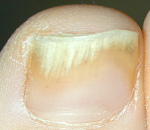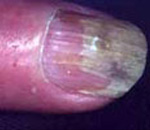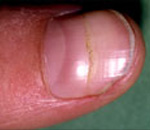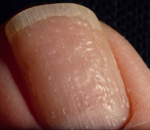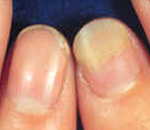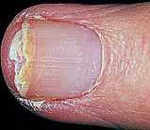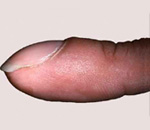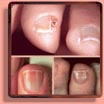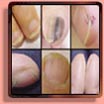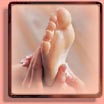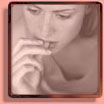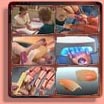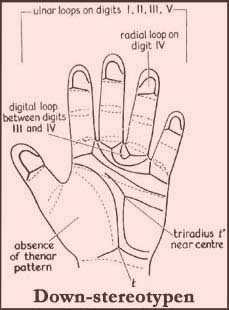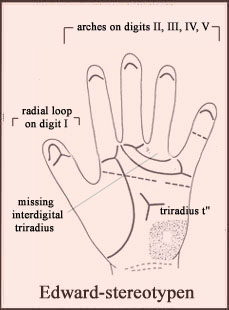
Medical Hand Reading in Clinical Diagnosis! Medical scientists discovered that the hand can be used as an indicator for medical problems. Dermatologists have found that some nail abnormalities communicate reliable info related to health problems (like for example: diabetes mellitus). And geneticists have observed that dermatoglyphic abberations are indicative for certain genetic syndromes - Down's syndrome [mongolism] - is the most wellknown example. However, other aspects of the hands can signal medical problems as well. The sequel of this page will show that most of these suspected 'medical' hand features can be observed in the hands of perfectly healthy people as well. In other words: in modern hand analysis one single 'abnormal' hand feature does not provide a basis to suspect that a person suffers on medical problems. • HANDS & CANCER: How hands may signal various types of cancer! • HANDS & DOWN SYNDROME: About the role of the simian line! • HANDS & FRAGILE-X SYNDROME: incl. simian line, Sydney line!  Synonyms: Hand Analysis - Palmistry - Palm Reading - Hand Reading - Cheirology
Medical assessment on the basis of the nails From the early 80's various works have been published which describe the clinical relevance of the nails. A classical example in this field is the work presented by Beaven & Brooks: Color Atlas of the Nail in Clinical Diagnosis (first print: 1984). During the past years various new books have been presented within this discipline. However, only a few years ago medical students were hardly informed about the clinical value of the nails. In order to fill this space several dermatologists have united their knowledge and created in 1997 'Nail-TutorTM': a visual personal computer program including 150 photo's which describe the anatomy and pathology of the nails - afterwards the user can test the understanding of the material in the program. In general one can say that only a some disease are frequently accompagnied with nail abnormalities. The following concerns an overview of the most well-known diseases + a description of the accessory nail abnormalities:
* ATTENTON: all (described) nail abnormalities can sometimes be observed in perfectly healthy people as well! In case you are worried about certain characteristics of your nails, please consult your general practitioner. ADDITIONAL TIPS:
MORE ABOUT FINGER NAILS:
Medical assessment on the basis of dermatoglyphics
Later other researchers have discovered that other genetic syndromes are accompagnied with dermatoglyphic abnormalities as well. Next to trisomy syndromes, these abnormalities are obsered in syndromes which are accompagnied with structural abnormalities in the chromosomes, an abnormal number of sexe chromosomes, and syndromes which are accompagnied with an abnormality on a specific gene. Another relevant factor appears to be the fact that the concerning syndromes are usually accompagnied with a high frequency of congenital heart disease. This rises the attempting question: • The Simian Line + 26 other hand markers in Down syndrome! Can (congenital) heart diseases be recognized via the dermatoglyphics This question was studied in several dozens of scientific programs and significant results have been reported frequently. Several studies identified significant results related to a high positioned axial triradius (which is frequently found to be related to the earlier mentioned genetic syndromes). However, some contradictive significant results have been reported as well. In other words: the above mentioned question has not been answered conclusive yet. PERSONAL OBSERVATIONS: I have conducted my own study on the hands of 10 subjects with (congenital) heart disease. Because of fact that this sample of subjects is very small I find it unusefull to present detailed statistics. However I would like to make notice that in the hands of some of these subjects I have identified interesting features which include e.g.:  • a (very) high positioned axial triradius • a whorl on the ring finger • a loop on the hypothenar (= the zone next to the thenar). By the way, in quite some of the studied subjects these dermatoglyphics features are accompagnied with a simian-related heartline or a Sydney line (= a very long headline). More about the simian-related heartline in the section Neuroticism. Finally I would like to make noticed that in far most of the publications about nails is being described that certain nail abnormalities are very frequently observed on subjects who have heart problems, such as: splinter hemorrhages and red lunala, check out: www.hps-online.com. * ATTENTION: all (described) dermatoglyphic patterns can be observed in the hands of perfectly healthy people as well! In case you are worried about certain hand features, please contact your general practitioner.
Medical assessment on the basis of the fingers
* ATTENTION: all (described) abnormalities can occasionally be observed in the hands of perfectly normal people kunnen! In case you are worried about certain abnormalities in your thumb or fingers, please contact your general practitioner.
Medical assessment on the basis of the hand lines Some traditional handanalysts assert that smal irregularities (like for example: breaks and islands) in the three 'primary' palmar hand lines are indicative for health problems. However, the non-specific character of the hand descriptions and the non-specific descriptions of the medical problems, indicates that these handanalysts might be inclined to overvalue their observations. Possibly these handanalysts incline to rely too much on the feedback of their clients: the section Handanalysis Psychology deals with the pitfalls which can arise in the interaction between the handanalyst and the client. In general one can say that scientific research has indicated that certain characteristics of the lines can indeed have some medical significance. However, in isolation these features have no value at all: only certain COMBINATIONS of features can provide a solid basis for a medical diagnosis. AN EXAMPLE: Various studies executed by medical researchers have shown that the so-called simian crease is observed in about 60% of people who have Down's syndrome (= mongolism).
Most scientific studies on the palmar lines were focussed merely on the simian line. And the Sydney line has been studied frequently as well. The diagnostic value of the other lines has not been established yet. However, it is premature to conclude form this observation that traditional handanalysts have gathered more insights on this matter. For, these 'alternative' insights have been contructed merely on the basis of anecdotal evidence - however the objective value of this anecdotal evidence has never been proven. MORE ABOUT THE SIMIAN CREASE: • The Simian Line: a notorious hand crease! • The Simian Line & Down syndrome! • The Simian Line & fragile-X syndrome! • Why is the simian line an unusual palmar crease?
Medical assessment on the basis of hand reflexes Primitive reflexes are automatic reflex actions of the body originating in the central nervous system. They are called "primitive" because they are among the reflexes found in newborns and infants, but may re-appear later in life due to illnesses, particularly those affecting the frontal lobes. If primitive reflexes retain past the first year of life (at the very latest) they can interfere with social, academic, and motor learning - sometimes resulting in: learning disorders, ADHD, Autism Spectrum, and various other neurodevelopmental disorders. More: Primitive reflexes of the hand: the power of survival & hand diagnostics! |
|
|
© COPYRIGHT 2002-2017: |
